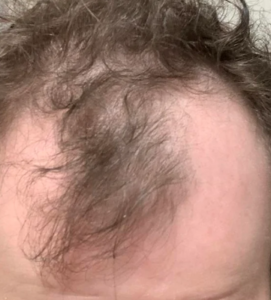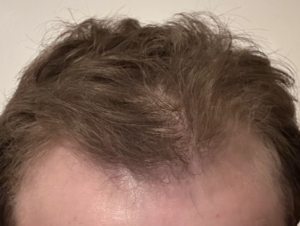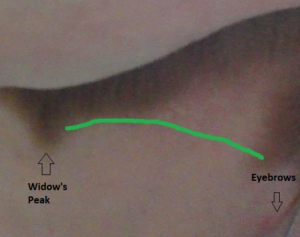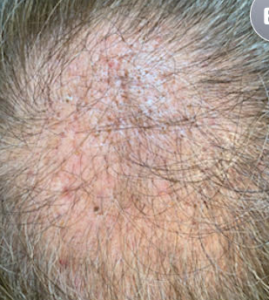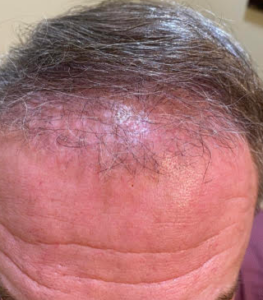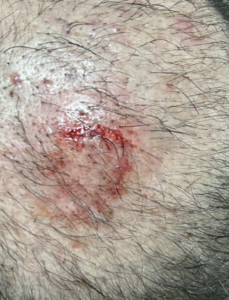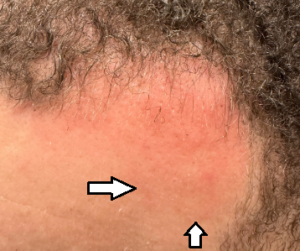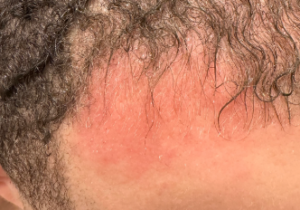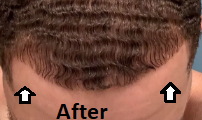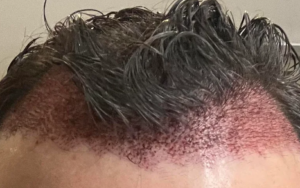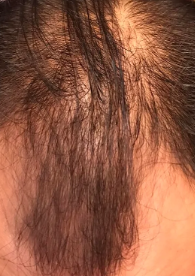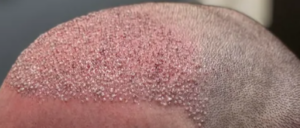This is a wonderful result and shows the power of microneeding at maximizing the results of medication and cause such good growth. A microneedling maintenance program should be continued at least once a month and if you see hair loss, then increase the frequency of the microneedling. Stay on the finasteride and the minoxidil.
[If you have any questions, you can reach me at williamrassman33@gmail.com]
From this single photo, I don’t think that you are balding. Your hairline is a V-shape, typical of a mature male hairline. The fact that you have a widow’s peak indicates the location of your juvenile hairline at the tip of the widow’s peak. What you have drawn is a female-shaped hairline. Get an expert to do the hairline for you. If you are planning a hair transplant, then you will have to live with this hairline for the rest of your life. Really want to do this?
[If you have any questions, you can reach me at williamrassman33@gmail.com]
This is a patient I treated with a single surgery last year with 3,300 grafts. The after photo is on the left. He was thrilled with the results, and now he doesn’t think about his hair much of the time, which is the takeaway here.
[If you have any questions, you can reach me at williamrassman33@gmail.com]
I know it isn’t a super bad case of MPB yet but I really don’t like these temporal recessions. They make me look old and I want them to go away. I’ve traced where my hairline used to be and I’m wondering: can it be restored with just fin + min or will I need to buy a hair transplant at some point?
I am not 100% sure that this is balding. To be sure, I need to see a frontal view with your eyebrows lifted high so that you forehead creases. That will tell me exactly where your hairline belongs, if it is receded, and by how much.
This may be an early Class 3 pattern of balding. If you are under 22, it will likely respond to minoxidil and finasteride. If you are over 26, if it doesn’t respond to the above medications, then try microneedling for 6 months, which should regrow your hair. If not, you can get a hair transplant if you have tried it all and are over 25, which will work well if this is balding. The design of your hairline you sent to me is clearly feminine. You need a good doctor to design it properly if you get a hair transplant, and it should be a mature MALE hairline.
Is shock loss after HT worse if you’re on fin and min than if wouldn’t be taking any medication? And how long does it last approximately? I’ve lost a lot of native hairs as well.
Finasteride takes time in some men. Give it a full year before drawing conclusions. I have found that in close to 100% of men, the drug will slow, stop, or reverse the hair loss. Slowing it down is common and sometimes hard to detect unless the drug is stopped, when hair loss will immediately accelerate. Stopping hair loss is less common, and reversing it is even less common (more common in men under 23). Finasteride is very effective at preventing hair loss
There is some good teaching in your photos. This is an outstanding regrowth of hair from microneedling and minoxidil. I want to call your attention to the corner area which received microneeding beyond (below) the natural adult mature hairline, which did not bring back the hair to the full extent of the microneddling. It is important to note that microneeding in areas where your juvenile hairline is lost, microneedling this area will not bring your juvenile hairline back. For those who are microneedling, please limit it to the mature hairline you want to return to.
[If you have any questions, you can reach me at williamrassman33@gmail.com]
I found this graph showing the various racial origins for various hair densities.
Reference: Interesting graph!Diversity in human hair growth, diameter, colour and shape. An in vivo study on young adults from 24 different ethnic groups observed in the five continents. Geneviève LOUSSOUARN, Isabelle LOZANO, Ségolène PANHARD, Catherine COLLAUDIN, Charles EL RAWADI. , Gilles GENAIN, L’OREAL Research and Innovation,
11-13 rue Dora Maar 93400 Saint-Ouen,,France, Eur J Dermatol 2016; 26(2): 144-54
Diversity in human hair growth, diameter, colour and shape. An in vivo study on young adults from 24 different ethnic groups observed in the five continents
Background: Based on previous findings, from a worldwide study, classified the shapes of human hair into 8 major types, from straight to highly curly. This clearly extended the usual classification of hair into African, Asian or Caucasian types. However, determinations of hair growth parameters and hair density were excluded from such studies. Objectives: To measure and compare the hair growth profiles of young adults without alopecia living in the five continents. Materials & Methods: 2249 young adults (18-35 years, females and males) without alopecia, originating from 24 various human ethnic groups were includedin the study. Total hair density, telogen percentage and growth rate on three different scalp areas were measured, using non-invasive validated techniques. Natural hair colour level, curliness and hair diameter were additionally recorded, when practically possible. Results: Diversity in hair growth parameters among the entire cohort was a key finding, with differences linked to scalp area, gender and geographic origin. Statistical approaches depicted African hair as having lower density and a slower growth rate. Asian hair showed a thicker diameter, with faster growth. Caucasian hair showed a high total hair density. Conclusion: On the one hand, this inter-continental study of hair growth parameters provides initial valuable base-line data on hair in young adults without alopecia, and on the other hand, further extends our knowledge of this unique human appendage.
Click to enlarge for details
[If you have any questions, you can reach me at williamrassman33@gmail.com]
After overcoming my initial fears about fin and now being on it, my worries have shifted to the possibility of it not working. Just asking about stopping loss not about regaining ground.
Finasteride takes time in some men. Give it a full year before drawing conclusions. I have found that in close to 100% of men, the drug will slow, stop or reverse the hair loss. Slowing it down is common, stopping it is less common, and reversing it is even less common (more common in men under the age of 23).
Specifically, is the spike in testosterone levels just an effect from the body adjusting to the finasteride?
Yes, it is the body’s feedback loop. Some men actually get an increased libido from the increase in testosterone. one of my friend’s son had that happen to him and he called me worried. His girlfriend loved it, so I told him to enjoy the experience.
From the longest time, I had been taking 0.5 mg of Finasteride daily yet was still losing ground. People said that the differences between the two doses were negligible, so I assumed that increasing the dose wouldn’t help. After seeing little progress over a year, I decided to bite the bullet and increased my dosage to 1 mg daily. The differences were noticeable within a few weeks. I had less shedding both in the shower and on the floor. In addition, my libido was slightly lower than before, but I took that as a sign of efficacy. And hey, I would personally rather have a full head of hair and have sex a little less often than the opposite. Fast forward to a few months later, and I’ve already noticed regrowth. Take my anecdotal testimony with a grain of salt, if you must, but let this be a warning, or perhaps a beacon of hope, to those who are unaware: there is a difference in dosage for some people. If your hair loss is aggressive, don’t be afraid to increase your dosage. Those few percentages can be the break point between losing and gaining.
In Mercks original study on Propecia, the 1mg dose was the recommended best dose. Thank you for sharing your experience. I hope you become a model for others who take shortcuts and don’t get the full benefits of the drug.
[If you have any questions, you can reach me at williamrassman33@gmail.com]
I am now 3 months after the surgery. The grafts have started to grow. This photo was taken one day after the surgery. What do you think?
This is a nice job. I hope that readers who go to Turkey note that you received 2000 grafts, not 5000 grafts. This means that your surgeon respected your donor reserves while covering the areas that were needed. I like your work and wish I would see more conservative use of grafts on those of you who go to turkey. Hair transplantation is not a race to see who can get more grafts in a single session.
[If you have any questions, you can reach me at williamrassman33@gmail.com]
I went to Turkey to get a hair transplant and the results were amazing. My confidence did a 180 and life really did get better. However, now I am noticing thinning in my hair transplant area and its starting to look pretty bad. Is this normal? I wonder if there is something I have done to damage the hair? My hairloss in general has been stable for the past 5 years and the only noticable area is the hair transplant.
It is possible that when they performed the FUE, they used a very small punch and, in the process, left the valuable stem cells behind which are located along the shafts of the follicular unit. FUE grafts are vulnerable to being removed too skinny. If that were the case, the hair might not regenerate into another hair cycle. How many grafts did you have done? Please show me the post-operative photos.
That is a lot of grafts for the frontal area. What happens if you lose the back as your hair loss progresses? Is there enough donor hair left to follow your balding? What is your Master Plan? Actually, I think what you did was overkill, using too many grafts. Let’s assume that you continue to bald as you get older. The donor supply is often around 6000-8000 grafts, and with a higher number, it is almost certain that you will have a see-through donor area unless your hair is coarse.
[If you have any questions, you can reach me at williamrassman33@gmail.com]
Page 22 of 1247


